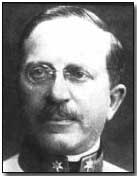Who's Who - Arz von Straussenberg
 General Arz von Straussenberg
(1857-1935) saw rapid promotion within the Austro-Hungarian army once war
was underway for the unusual distinction of demonstrating consistent success
in command, a rare commodity among Austro-Hungarian commanders.
General Arz von Straussenberg
(1857-1935) saw rapid promotion within the Austro-Hungarian army once war
was underway for the unusual distinction of demonstrating consistent success
in command, a rare commodity among Austro-Hungarian commanders.
Appointed a corps commander attached to the Austrian First Army on the
Eastern Front with the declaration of war in August 1914, Straussenberg
quickly earned praise for his part in Gorlice-Tarnow operations in the
German Bug Offensive of May-June 1915.
Consequently he was given,
in 1916, command of First Army. Success continued as he led it to
victory in the Romanian campaign.
With the ascent of Karl I
to the throne (in place of
Franz-Josef), and
the former's desire to seek change among the command hierarchy,
Straussenberg was handed the role of Commander in Chief on 1 March 1917,
replacing the erstwhile
Conrad von Hotzendorf.
It was too late however for the undoubtedly talented Straussenberg to save
the Austro-Hungarian army from disintegration. He later complained,
with probable cause, that his scope for manoeuvre was limited with the
constant interference of the Emperor in command decisions.
Indeed, Straussenberg's role appears more to have been one of advisor to Karl than Commander in Chief; he was ennobled by the latter in 1918.
Nevertheless, Straussenberg did encounter limited success in his new role, both in repelling the Kerenski Offensive of summer 1917 and for his part in the successful Caporetto offensive later that autumn.
Such victories were however overshadowed by Straussenberg's (albeit reluctant) support for a two-pronged attack along the Piave River in June 1918 (led by Conrad and Boroevic). Ending in failure, this hastened the final disintegration of the army.
A man without any political ambitions whatsoever, Straussenberg went into retirement with the end of the war. He died in 1935.
Click here to read Arz von Straussenberg's official praise of the German Army during the Spring Offensive of 1918.
'White Star' was a German mixture of chlorine and phosgene gas, so-named on account of the identification marking painted on the delivery shell casing.
- Did you know?
